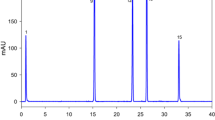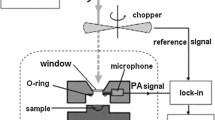Abstract
In this study, the determination of lutein in fresh and frozen spinach leaves has been done. Changes of pigment concentration in spinach leaves were observed in various heating time periods (1–20 min). An improved and simplified analytical method which offers rapid, accurate determination and identification of lutein in spinach samples is reported. During experiments, two detection systems, ultraviolet–visible (UV–vis) spectroscopy and Corona CAD coupled with high-performance liquid chromatography (HPLC), were applied. The determination of lutein in plant extracts was carried out by HPLC–UV–vis. Concentrations of lutein ranged between 0.43 and 0.88 mg/g xfor three frozen spinach samples and 0.83 mg/g for fresh spinach, respectively. Changes of lutein concentration after cooking of frozen spinach were also determined. Primary concentration of lutein in examined frozen spinach sample was 0.43 mg/g. After a 1-min heating time, the concentration of lutein was 0.46 mg/g. After 20 min, it was only 0.11 mg/g. The decreasing of lutein concentration in spinach during the cooking from 2 to 20 min was observed. Over a 20-min heating time of spinach leaves, a loss of primary concentration of lutein was observed. Short cooking time (1–2 min) of spinach has an effect in the increasing of contents of lutein and other biologically active compounds. Long cooking time of spinach induces lutein degradation process.




Similar content being viewed by others
References
Ahmed SS, Lott McGregor N, Marcus DM (2005) The macular xanthophylls. Surv Ophthalmol 50(2):183–193
Alves-Rodrigues A, Shao A (2004) The science behind lutein. Toxicol Lett 150:57–83
Aman R, Carle R, Conrad J, Beifuss U, Schieber A (2005) Isolation of carotenoids from plant materials and dietary supplements by high-speed counter-current chromatography. J Chromatogr A 1074:99–105
Bernstein PS, Khachik F, Carvalho LS, Muir GJ, Zhao DY, Katz NB (2001) Identification and quantitation of carotenoids and their metabolites in the tissues of the human eye. Exp Eye Res 72:215–223
Bone RA, Landrum JT, Friedes LM, Gomez CM, Kilburn MD, Menendez E, Vidal I, Wang W (1997) Distribution of lutein and zeaxanthin stereoisomers in the human retina. Exp Eye Res 64:211–218
Bone RA, Landrum JT, Dixon Z, Chen Y, Llerena CM (2000) Lutein and zeaxanthin in the eyes, serum and diet of human subjects. Exp Eye Res 71:239–245
Boulton M, Różanowska M, Różanowski B (2001) Retinal photodamage. J Photochem Photobiol B Biol 64:144–161
Dachtler M, Kohler K, Albert K (1998) Reversed phase high-performance liquid chromatographic identification of lutein and zeaxanthin stereoisomers in bovine retina using a C30 bonded phase. J Chromatogr B 720:211–216
Edge R, McGarvey DJ, Truscott TG (1997) The carotenoids as anti-oxidants—a review. J Photochem Photobiol B Biol 41:189–200
Granado F, Olmedilla B, Blanco I (2003) Nutritional and clinical relevance of lutein in human health. Brit J Nutrit 90:487–502
Hart D, Scott KJ (1995) Development and evaluation of an HPLC method for the analysis of carotenoids in foods, and the measurement of the carotenoid content of vegetables and fruits commonly consumed in the UK. Food Chem 54:101–111
Jiang XY, Chen LS, Zhou ChS (2005) Lutein and lutein esters in marigold flowers by high performance chromatography. J Cent South Univ Technol 12(3):306–308
Khachik F, Bernstein PS, Garland DL (1997) Identification of lutein and zeaxanthin oxidation products in human and monkey retinas. Investig Ophthalmol Vis Sci 38(9):1802–1811
Lakshminarayana R, Aruna G, Kumar Sangeetha R, Bhaskar N, Divakar S, Baskaran V (2008) Possible degradation/biotransformation of lutein in vitro and in vivo: isolation and structural elucidation of lutein metabolites by HPLC and LC-MS (atmospheric pressure chemical ionization). Free Radical Biol Med 45:982–993
Liang Y, White WS, Yao L, Serfass RE (1998) Use of high-precision gas isotope ratio mass spectrometry to determine natural abundance 13C in lutein isolated from C3 and C4 plant sources. J Chromatogr A 800:51–58
Lienau A, Glaser T, Tang G, Dolnikowski G, Grusak MA, Albert K (2003) Bioavailability of lutein in humans from intrinsically labeled vegetables determined by LC-APCI-MS. J Nutr Biochem 11:663–670
Mozaffarieh M, Sacu S, Wedrich A (2003) The role of the carotenoids, lutein and zeaxanthin, in protecting against age-related macular degeneration: a review based on controversial evidence. Nutr J 2:20
Perry A, Rasmussen H, Johnson EJ (2009) Xanthophyll (lutein, zeaxanthin) content in fruits, vegetables and corn and egg products. J Food Compos Anal 22:9–15
Plante M, Bailey B, Acworth I (2010) The use of charged aerosol detection with HPLC for the measurement of lipids. Methods Mol Biol 579:469–482
Quach HT, Steeper RL, Griffin GW (2004) An improved method for the extraction and thin-layer chromatography of chlorophyll a and b from spinach. J Chem Educ 81(3):385–387
Rao AV, Rao LG (2007) Carotenoids and human health. Pharmacol Res 55:207–216
Rapp LM, Maple SS, Choi JH (2000) Lutein and zeaxanthin concentrations in rod outer segment membranes from perifoveal and peripheral human retina. Investig Ophthalmol Vis Sci 41(5):1200–1209
Schalch W, Cohn W, Barker FM, Köpcke W, Mellerio J, Bird AC, Robson AG, Fitzke FF, van Kuijk FJGM (2007) Xanthophyll accumulation in the human retina during supplementation with lutein or zeaxanthin—the LUXEA (LUtein Xanthophyll Eye Accumulation) study. Arch Biochem Biophys 458:128–135
Swartz M, Emanuele M, Awad A, Hartley D (2009) Charged aerosol detection in pharmaceutical analysis: an overview. LCGC North America, April 1, Special Issues; http://Chromatographyonline.findanalytichem.com
Tsao R, Yang R, Young JCh, Zhua H, Manolis T (2004) Separation of geometric isomers of native lutein diesters in marigold (Tagetes erecta L.) by high-performance liquid chromatography–mass spectrometry. J Chromatogr A 1045:65–70
Acknowledgements
The authors wish to thank Judyta Piotrowska, MSc for her technical assistance. The authors thank Prof. A. Horna from Radanal Ltd. for the donation of Corona CAD detector.
Author information
Authors and Affiliations
Corresponding author
Rights and permissions
About this article
Cite this article
Ligor, M., Buszewski, B. Study of Xanthophyll Concentration in Spinach Leaves by Means of HPLC Coupled with UV–VIS and Corona CAD Detectors. Food Anal. Methods 5, 388–395 (2012). https://doi.org/10.1007/s12161-011-9256-7
Received:
Accepted:
Published:
Issue Date:
DOI: https://doi.org/10.1007/s12161-011-9256-7




